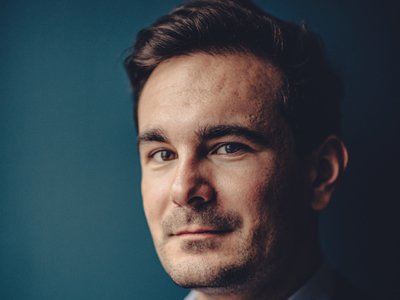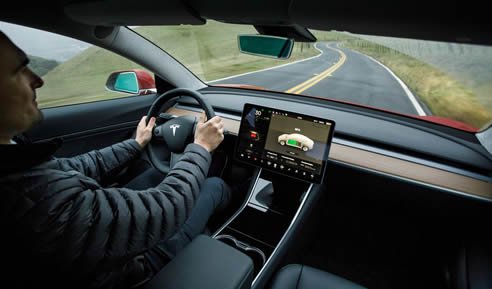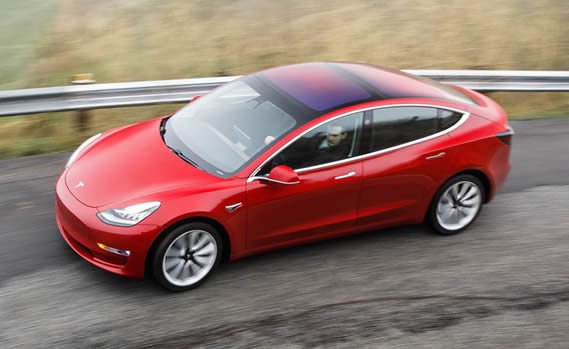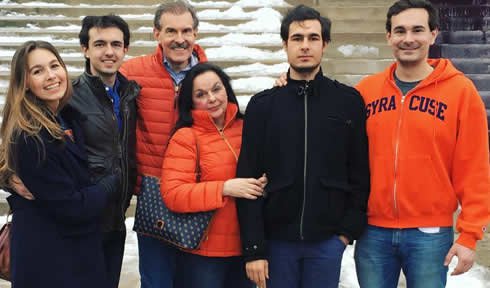Life in the Fast Lane
Road & Track's Bob Sorokanich '08 has gone from med school dropout to automotive bard

Last fall, Bob Sorokanich ’08 tweeted Tesla celebrity CEO Elon Musk, asking to test-drive his company’s new Model 3.
Sorokanich, who is Road & Track’s deputy online editor, may have been half-joking, but ten minutes later, Sorokanich got a call from one of Musk’s lieutenants: “Elon wants to get you in a car. How do we make that happen?”
No sooner had the calendar flipped to 2018 than Sorokanich was nearing the Tesla campus, nestled in the rolling hills of San Francisco’s East Bay. Musk had arranged for him to spend the day with chief designer Franz von Holzhausen, who has been in charge of design at Tesla since 2008 and has helped it become the world’s foremost electric carmaker. “Hundreds of thousands of people are awaiting delivery of the Model 3, bringing electric cars into the mainstream,” says Sorokanich, speaking by phone from his office in Midtown Manhattan. “I was fortunate to be one of the first journalists to drive one.”

Although Sorokanich is a seasoned pro, having made more than 300 test drives, he still beams at the thought of von Holzhausen tossing him the keys to the most anticipated car in auto history—a top-spec Model 3 valued at $52,500. (Base models, due to roll off the assembly line later this year, are $35,000.) Sorokanich’s bright-red loaner had all the trimmings: a long-range battery; heated, 12-way adjustable front seats; a premium audio system; and a giant touchscreen in the center of the dashboard (an "exercise in fanatical minimalism," he notes), controlling all the car’s functions.
“My goal was to approach the Model 3 the way an enthusiast would, combining spirited backroad driving with regular highway commuting,” says Sorokanich, who joined Road & Track in 2014, after a reporting stint at Gawker Media. “As soon as we pulled out of the factory, I could tell the Model 3 was different. We went from zero to 60 in 4.9 seconds. The 50 to 70 sprint took two and a half [seconds]. It was amazing to be in a luxury sedan and put the pedal to the floor without downshifting. As I said in my review, it was like having the ‘world’s un-laggiest turbo motor.’”
Just as the Model 3 is high-performance art, so is Sorokanich’s writing. His ability to make the complex simple and to hone a phrase that puts the reader in the middle of the action reveals a nimble mind. Leave it to Sorokanich to compare the “slap of thrust” that occurs before one’s foot hits the floor to a “flood of electrons.” Such well-turned phrases animate his work. Others include homages to the Model 3’s “knife-sharp steering,” the car’s “unflappable grip” and the drivetrain’s “subterranean center of gravity and snappy acceleration.”
It is one thing to discover journalism that, to quote Sorokanich, “tickles the pleasure-neurons of autocrossers and track rats”; it is another to offer “such immediate, unfettered brightness to regular, non-gearhead drivers.” He inhabits both worlds.

Sorokanich’s published review was so compelling that Tesla recently emailed it to more than a half-million Model 3 reservation owners. “It was nice and generous of Tesla to do that,” Sorokanich says. “It also is an intense form of scrutiny. Tesla fans are extremely enthusiastic about this car and Elon Musk and all the things he does beyond Tesla. … Part of the reason he is a cultural icon is because he does the opposite of what everybody expects from a major company CEO.”
The same is true of Sorokanich—a successful biochemistry major in the College of Arts and Sciences (A&S) and member of the Renée Crown University Honors Program who, after two years of medical school, embarked on a full-time writing career. Samuel Gorovitz, then the Honors Program’s founding director, applauds Sorokanich’s decision to steer in a different direction. “Bob courageously reinvented himself as he reassessed the path he had long assumed was his to follow,” says Gorovitz, also a professor of philosophy and former dean of A&S. “People often persist in doing what they believe they are supposed to do, even having lost all passion for the pursuit. Bob teaches us that it need not be that way.”
Road & Track probably was the last thing on Sorokanich’s mind 10 years ago, almost to the month, when his Honors Capstone Project got top prize at Syracuse. His thesis—a two-year study of the effects of platinum-based anticancer drugs on DNA, supervised by Chemistry Professor James Dabriowak—culminated with a paper in Chemistry & Biodiversity (John Wiley & Sons, 2008), of which Sorokanich was a lead author. The award also secured his place in what is now Sidney Kimmel Medical College at Philadelphia’s Thomas Jefferson University.
“The first two years of med school were a mixture of classroom and lab time,” Sorokanich recalls. “After that, there’s a natural break point in which people decide to pursue M.B.A.s or Ph.D.s in conjunction with their medical degrees. I ran full-steam in the opposite direction.”
Sorokanich had always wanted to be a doctor, and the fact he got into his first-choice medical school underscores his business bravado. “Bob is incredibly smart, talented and outgoing,” says his sister, Lara ’15, associate editor of Popular Mechanics Magazine. “While it was scary to see him make such a big decision, I think we believed he would find his way. We never imagined something as perfect as Road & Track, but we had high expectations.”
Sorokanich credits Gorovitz and Cathryn Newton for steering him toward a new direction. He cites “Linked Lenses: Science, Philosophy and the Pursuit of Knowledge” (HNR 350), which Gorovitz and Newton co-teach in Honors, as a flashpoint of his education. “That course opened my eyes, and led me to where I am today,” says Sorokanich, who, admittedly, came to Syracuse with a “pretty narrow idea” of what he wanted to do. “I wanted to get a degree in biochemistry, but, in the process, discovered philosophy, writing and literature. 'Linked Lenses' showed me how to think about and evaluate the world in a completely new way. It gave me license to explore all these new and different avenues that hadn’t even dawned on me.”

At Syracuse, Sorokanich dabbled in journalism and creative writing, and occasionally wrote columns for The Daily Orange. Maggie Gordon ’08, a dual major in women’s and gender studies in A&S and newspaper journalism in the Newhouse School, was drawn to his precocious imagination. “Bob was the person I’d turn to when I was on deadline, and needed someone for a quick read-through. He’d always catch something,” she says. “His grammar is impeccable. And his vocabulary is ridiculous.”
The two struck up a special friendship, and dated during their senior year. Gordon remembers Sorokanich’s penchant for three-syllable words: “I’d take to texting my best friends these words he’d drop, and we’d laugh and look them up together.” She also recalls his ability to revel in all matter of critical thinking, research and reflection. “He’s a doodler who can kill a ‘Jeopardy!’ category, chock full of facts about ancient civilizations, and then deconstruct and rebuild a Miata,” adds Gordon, a features writer at the Houston Chronicle. “Now that he’s writing about cars—a topic on which he’s got a freakish amount of expertise—he writes with authority, but drops enough colloquialisms into what he says so that you don’t feel intimidated reading him.”
Newton, dean emerita of A&S and professor of interdisciplinary and Earth sciences, underscores that Sorokanich is a creative risk-taker. “Bob has a creative edge and a spirit of restlessly testing ideas,” says Newton, also special advisor to the Chancellor and Provost for faculty engagement. “He brought these into his prizewinning Chemistry Honors capstone here—yet they are expressed even more fully in his dazzling writing now at Road & Track.”
At Syracuse, Sorokanich’s work ethic permeated all areas of his life. If he was not in the lab doing research, he was poring over books in Bird Library. Senior Sundays at Faegan’s? Not likely. “Bob would meet us when the library closed,” Gordon adds.
Proof of Sorokanich’s interest in cars spiked at graduation, when he sunk his Honors Capstone winnings into a 1988 Jeep Wrangler—a “death trap with Swiss cheese floorboards,” Gordon says, that dripped so much oil, his parents refused to let him park it in the driveway. Sorokanich later immortalized the car, named Reggie, in a micro-essay titled “400 Words About a Jeep I’ll Never Forget.”
Growing up in the Pennsylvania Rust Belt, Sorokanich tinkered with cars at an early age. He tells the apocryphal story of learning to read by looking at car ads. “My mom says that I associated logos with words—you know, the famous bowtie logo with Chevy and the blue oval with Ford,” he says. “I cannot remember a time when I wasn’t thinking about cars.”
It was more than prophetic that Sorokanich’s parents got him a Road & Track subscription for his ninth birthday. A year later, he won the Kids Art Contest as part of the magazine’s 50th anniversary celebrations. “There’s a picture of my drawing and me in the July 1997 issue,” he boasts. “I won a year’s subscription and tickets to the New York International Auto Show. How was I supposed to know that, 20 years later, I would cover the same show for the magazine that originally brought me there when I was 10?”

Sorokanich’s family bleeds Orange. In addition to his parents being alumni, his siblings Lara and Stephen graduated in 2015. Sorokanich’s youngest brother, David, is a junior in Newhouse. “Each of our experiences was unique, but, at the end of the day, we know where the Quad is, and what 13-degree days in January feel like,” Lara says. “We all root for the same team.”
For all his success at Syracuse, Sorokanich wanted more out of life than being a doctor. Gordon recalls the many times he asked her to change his password to The Car Lounge online forum, so he could concentrate on his med school studies, instead of scrolling the boards. “I would inevitably change his password to ‘TaylorSwiftForever,’ and, a month later, when he asked me to change it again, I would reset it to something like ‘ManBaconManlyCar,’” she confides.
Sorokanich was 27 years old when he became an “editorial fellow” (read “intern”) at Gawker in New York City. In time, he became a staff writer, turning out 10-12 articles a day about science, technology and healthcare.
During this period, Sorokanich not only began writing about cars, but also found his voice as a journalist. An unsolicited LinkedIn message about a possible gig at Hearst Digital Media, owner of Car and Driver and Road & Track, nearly knocked him out of his chair. He worked briefly as a reporter in Hearst Autos Group, before taking over Road & Track’s breaking-news commentary and analysis in the fall of 2015.
Nowadays, Sorokanich test-drives cars for several days to a week. (The Model 3 was an exception; he had it for 18 hours.) International travel is fast becoming de rigueur, along with untold hours of town driving, high-speed highway driving and track driving under controlled and often grueling conditions.
“I try to describe the experience in a way that makes you feel like you’ve driven the car after reading my article,” Sorokanich says. “When I started out, nobody gave me the keys to anything. Last summer, I test-drove the new Lamborghini Centenario, of which there are only 20 examples in the world. The car is so exclusive that you have to apply for the honor of spending $2.2 million to buy it.”
Lara thinks her brother’s passion for cars comes through in his writing. She says that whether he is reviewing a $20,000 hatchback or a $100,000 sports car, his enthusiasm is infectious. “When something about a car is great, Bob is excited to acknowledge it. Likewise, when a car doesn’t deliver, he’s not afraid to be honest about it,” says Lara, who was a dual major in magazine journalism in Newhouse and Middle Eastern studies in A&S and the Maxwell School. “I think that’s because, as an auto enthusiast, Bob does not mislead. He presents the truth in relatable terms.”
Such qualities have made Sorokanich a patient, effective teacher. Gordon recalls the time, prior to graduation, he taught her to drive a stick shift. “I was days away from a 4,000-mile road trip,” she says. “Bob called up a friend of his, and asked to borrow a 20-year-old Toyota with a standard transmission. He drove me to a Wegmans parking lot, where I took roughly five years off that clutch’s life.”

Speaking of which, Sorokanich loves double clutching. Gordon talks about how he used to drive his dad’s convertible under a bridge near the family home in Clarks Summit, north of Scranton. “The acoustics there were echo-y and beautiful. If Bob double-clutched at the right time, [the car] would boom and echo in a way that sounded like a symphony to him,” she recalls. “He’d just smile, like there was no better thing in the world.”
Sorokanich adds, aptly, “My path started taking on a direction when I stopped trying to steer.”
